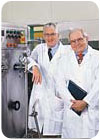
Q: Can You Use Accelerated Shelf-life Methods With Ice Cream?
A: Accelerated shelf-life testing should be applied to provide an early indication of how well ice cream will maintain its properties during storage and distribution. The information it supplies is important to understand what affects shelf-life and eventual consumer acceptability.
The shelf-life of ice cream is determined by when, and under what conditions, a product feature fails. Microbiological, chemical and some physical features rarely change after ice cream is hardened, stored or distributed. However, sensory properties-flavor, body and texture-do change when ice cream is exposed to high temperatures and temperature fluctuations (i.e., heat shock). Sensory properties determine acceptability and, in turn, help set shelf-life expectations. Time and temperature, of course, play a key role, but conditions of storage, distribution and use of ice cream vary over a near infinite number of conditions.
It is important to have an accelerated test or tests that reflect formulation, manufacturing, packaging, storage and distribution reality. Test methods need also to be accurate (measure what they are intended to measure), precise (repeatable), easy to apply (practical) and rapid.
An effective protocol can be created by properly designing tests with controls to verify that a specific test protocol and/or hardware have performed adequately to ensure that test-to-test variability is understood, and to frame a range of acceptability. This can help create a practical "window of acceptability" that can be both accurate and precise. This "window of acceptability" will include elements of appearance, body, texture, flavor quality, aroma, taste, melt behavior and overall eating quality.
Methods can use traditional "uncontrolled" home-style freezers, upright retail freezers, horizontal coffin freezers, controlled temperature chambers, and microwave treatments to simulate thermal abuse. Care is necessary within any given approach as natural and unnatural variables can affect results and any decisions made.
A basic approach is to cycle product between frozen storage and ambient room conditions. This approach is simple, but has shortcomings related to poor control of conditions, per se, and the influence of package size and timing. As a result, there can be a lack of agreement between the observations of the evaluation panel members, depending upon from where in the package they have taken their product portion.
More uniform thermal abuse can be applied using microwave heating. This can allow for quick screening of variables that affect freeze/thaw stability. Small sample sizes work best, but unless the microwave is engineered properly and/or time is allowed between sampling, microwave energy itself can vary from sample-to-sample. Further, mix composition and size and shape of inclusions can cause uneven heating and loss of control.
Effective approaches use horizontal coffin freezers in which defrost cycles and temperature conditions can be pre-set and managed. Temperature conditions within the freezer itself and freezer design can vary significantly and adequate product controls are necessary to make adequate comparisons sample-to-sample and test-to-test.
Although upright freezers reflect market reality, the variability of temperatures during the opening and closing of doors makes use of these freezers undesirable.
More sophisticated testing can be done using an enclosed freezing chamber in which temperatures are closely controlled and thermal abuse programmed into a microprocessor. The addition of a capability to control atmospheric pressure can add to the range of distribution conditions that can be simulated accurately and precisely. Changes in atmospheric pressure can affect shelf-life through an influence on ice cream structure by expansion and/or shrinkage of air cells. To evaluate pressure effects, ice cream packages are placed into a hermetically sealable chamber in which the pressure is then reduced to an appropriate level. The samples in the chamber are then placed into frozen storage involving whatever temperature fluctuation is relevant.
When properly designed and executed, accelerated shelf-life testing can be a highly effective way to predict freeze/thaw stability, protect product quality, engineer finished ice creams with superior freeze/thaw performance, extend shelf-life, and reduce the risks associated with accepting "bad" product and rejecting "good' product.
Accelerated shelf-life testing is detailed at Tharp & Young On Ice Cream Technical Short Course, Workshop and Clinics (www.onicecream.com) Nov. 29-Dec. 1, 2006, Las Vegas, NV. For more information on topics, registration, and tuition discounts, visit www.onicecream.com or call 610/975-4424 or 281-/596-9603.


